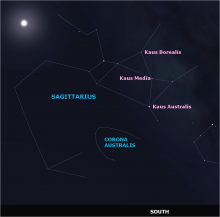Listen to today's episode of StarDate on the web the same day it airs in high-quality streaming audio without any extra ads or announcements. Choose a $8 one-month pass, or listen every day for a year for just $30.
You are here
Moon and Jupiter
The night sky is filled with beautiful objects with beautiful names — names from ancient Arabic, Greek, and Latin. But the most prominent object in the night sky doesn’t have one of those names. It’s the Moon — a name that means — well, the Moon. The name is a little more lyrical in other languages — Luna in Spanish, Lune in French — but they all mean the same thing. There’s no real story behind any of them.
That’s not the case for the moons that orbit the brilliant planet Jupiter, which is to the left of the Moon early this evening.
Jupiter’s first four moons were discovered in 1610. Since they attended Jupiter — the king of the Roman gods — eventually they were given names associated with Jupiter. Callisto, Europa, and Ganymede were all seduced by Jupiter, while Io was driven mad by his jealous wife.
The next Jovian moon wasn’t discovered until almost three centuries later, but astronomers stuck with the naming theme. They chose Amalthea, after a nymph who had nursed the young Jupiter.
Later discoveries also kept the theme, but widened it a bit — they included characters related to Zeus, the Greek god whom the Romans adopted as Jupiter. So that gave us names like Sinope and Lysithea.
That tradition continues today, although it takes a little more work. Even though Jupiter and Zeus were grand characters with rich histories, even they eventually ran out of nursemaids and partners.
Script by Damond Benningfield



